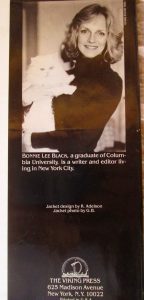For a long time he was my favorite living American writer. You might say I idolized him. I read William Styron’s books worshipfully, knowing full well I could never emulate his writing. He belonged to a too-lofty pantheon, way beyond my reach.
I clearly remember reading Styron’s 562-page novel Sophie’s Choice in one weekend when it came out in 1979. I was living in New York at the time, in a studio apartment on Riverside Drive, working on my own first book for Viking Press, Somewhere Child. I remember doing nothing else that weekend — hardly budging from my reading chair to eat or sleep or shower or dress – physically immobilized yet emotionally and spiritually swept away by Styron’s wrenching story and his transcendent words.
I remember falling in love with William Styron that weekend. Not in a romantic sense but in a kind of misty adoration. I’d always been an avid reader of good books; but this book, in that moment, when I was struggling to write the story of my missing daughter, spoke to me like no other book ever had. I resolved to send a copy of Somewhere Child to Styron as a thank-you gift, as soon as it was published.
So I did.
I sent it to him in care of his publisher, Random House, in New York. And I included a note in it to the effect, as I recall, that I believed if Sophie had been a real person and had lived to write her own story, her words and tone might have been similar to mine.
I never expected a reply. That would have been tantamount to expecting a personal letter from God on embossed stationery. Nevertheless, it came. William Styron wrote to me, in longhand (I remember he had a bold, distinctive, vertical handwriting) on one side of an elegant, cream-colored 5 x 8-inch card, thanking me for the gift of my book and telling me he looked forward to reading it.
As I read this, I immediately saw him sitting in his own reading chair in his study at his farmhouse in Connecticut, reading my book. Reading my words. William Styron and I would be connected – forever, I thought — by our respective written words.
But his message on the card went on. Its last line took my breath away: He said that from my author photo on the book’s jacket I reminded him of Sophie.
(So the Sophie of his book’s title was in fact a real person, a real woman whom he had really loved? I wondered. I wanted to ask him, but I was too shy to write back.)
Of course I framed his note and hung it on the wall near my desk overlooking the Hudson River so I could reread it every day (until, in time, the ink faded to invisibility).
And of course I had to attend a reading Styron did in New York some time after this. I sat alone in the crowded audience, in my favored middle-middle row seat, adoringly anticipating The Man’s arrival on the stage. I worried that I wouldn’t have the nerve to approach him afterward and introduce myself. I was sure he would have forgotten me. I fidgeted.
And then, after he entered, as he ad libbed and read, I could see he was unsteady. He slurred his words. He appeared to me to be drunk. He reminded me of the alcoholic father I feared throughout my childhood. Without falling from the stage, William Styron fell from the pedestal I’d built for him in my mind. I left the auditorium with the crowd, never attempting to meet him face to face. My adoration ended.
But that was then. And this is now.
I’m reading Styron’s award-winning novel Sophie’s Choice again now, after more than forty years. I’m reading it slowly this time, savoring every sentence and paragraph, drinking in his words. I realize I’d raced through my first reading in 1979, wondering, breathlessly, What will happen next?! Where will this story lead? But now that I’m much older and have spent most of my adult life as a writer, I’m asking other questions as I read, such as, How did Styron DO that? How did he perform such magic on the page?
I’m reading it as an eBook now, highlighting nearly every other paragraph, rereading and notating the highlighted sections, analyzing, studying. Learning.
My takeaway from this experience is to suggest that we who are older now might want to take the time to return to the books that shaped us when we were young. Revisit the authors who spoke to us then and see what they have to say to us now. For me, William Styron is no longer my favorite living American writer (he died in 2006 at the age of 81), but I find my love for him has been revived. He still speaks to me, but differently. And I cherish – and need — his words.
~ ~ ~ ~ ~
A special note: Big thank-you’s to all of you who have written to me and sent selfies holding copies of your just-received Sweet Tarts. My shipment of books has not yet arrived here in San Miguel de Allende, Mexico, so I have yet to hold a copy of my newborn book in my hands. Soon!

